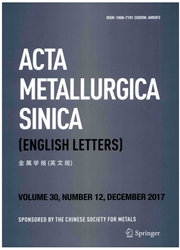

 中文摘要:
中文摘要:
A 0.2C-1.5Mn-1.5Si-0.6Cr-0.05Nb (wt%) 钢被过程并且传统的熄灭和 tempering (Q&T ) 为比较处理的新奇 quenching-partitioning-tempering (Q-P-T ) 分别地对待。X 光检查衍射分析显示 Q-P-T 钢有大约 10% 保留的奥氏体,但是 Q&T 钢几乎没有一个。随从 7 nitic 的压缩紧张率的增加,铁酸盐,而是它与温度增加展出力量的更慢的减少。在小粒的 bainite 和 bainitic 铁酸盐的脱臼密度在高温度经由恢复和再结晶减少。然而, bainite 再热什么时候低于 600 在温度被执行??
 英文摘要:
英文摘要:
A 0.2C-1.5Mn-1.5Si-0.6Cr-0.05Nb (wt%) steel is treated respectively by novel quenching-partitioning-tempering (Q-P-T) process and traditional quenching and tempering (Q&T) process for comparison. X-ray diffraction analysis indicates that Q-P-T steel has about 10% retained austenite, but Q&T steel hardly has one. With the increase of com- pression strain rate from 7 × 10^2 to 5 × 10^3 s^-1, the flow stress of Q-P-T steel increases, which demonstrates the positive strain rate effect, but does not exist in Q&T steel. The characterization of scanning electron microscopy indicates that a large number of long, straight martensite laths in Q-P-T steel will bend or be destroyed by large compressive strain of 35% at 5 × 10^3 s^-1. However, relative small compressive s~xain of about 5% at 7× 10^2 s^-1 almost does not have any effect on the original lath morphology. The characterization of transmission electron microscopy further reveals the origin of the positive strain rate effect and the microstructural evolution during dynamic compressive deformation.
 同期刊论文项目
同期刊论文项目
 同项目期刊论文
同项目期刊论文
 High strength-elongation product of Nb-microalloyed low-carbon steel by a novel quenching–partitioni
High strength-elongation product of Nb-microalloyed low-carbon steel by a novel quenching–partitioni Unique impact of ferrite in influencing austenite stability and deformation behavior in a hot-rolled
Unique impact of ferrite in influencing austenite stability and deformation behavior in a hot-rolled The effect of intercritical annealing on the Microstructure and Mechanical Properties in a high Stre
The effect of intercritical annealing on the Microstructure and Mechanical Properties in a high Stre Effect of intercritical annealing time on the microstructures and tensile Properties of a high stren
Effect of intercritical annealing time on the microstructures and tensile Properties of a high stren Effect of Partial Replacement of Si with Al on the Microstructures and Mechanical Properties of 1000
Effect of Partial Replacement of Si with Al on the Microstructures and Mechanical Properties of 1000 Development of Multi-Cycle Quenching–Partitioning–Tempering Process and Its Applications in Engineer
Development of Multi-Cycle Quenching–Partitioning–Tempering Process and Its Applications in Engineer Characterization of microstructures and tensile properties of TRIP-aided steels with different matri
Characterization of microstructures and tensile properties of TRIP-aided steels with different matri Significance of control of austenite stability and three-stage work-hardening behavior of an ultrahi
Significance of control of austenite stability and three-stage work-hardening behavior of an ultrahi Dynamic Compression Behavior and Microstructure of a Novel Low-Carbon Quenching-Partitioning-Temperi
Dynamic Compression Behavior and Microstructure of a Novel Low-Carbon Quenching-Partitioning-Temperi Multi-phase microstructure design of a novel high strength TRIP steel through experimental methodolo
Multi-phase microstructure design of a novel high strength TRIP steel through experimental methodolo Investigation on High Strength Hot-Rolled Plates by Quenching-Partitioning-Tempering Process Suitabl
Investigation on High Strength Hot-Rolled Plates by Quenching-Partitioning-Tempering Process Suitabl Enhanced stability of retained austenite and consequent work hardening rate through pre-quenching pr
Enhanced stability of retained austenite and consequent work hardening rate through pre-quenching pr Work hardening behaviors of a low carbon Nb-microalloyed Si–Mn quenching–partitioning steel with dif
Work hardening behaviors of a low carbon Nb-microalloyed Si–Mn quenching–partitioning steel with dif Deformation temperature dependence of mechanical properties and microstructures for a novel quenchin
Deformation temperature dependence of mechanical properties and microstructures for a novel quenchin Microstructual Evolution of a Nb‐Microalloyed Advanced High Strength Steel Treated by Quenching‐Part
Microstructual Evolution of a Nb‐Microalloyed Advanced High Strength Steel Treated by Quenching‐Part A new effect of retained austenite on ductility enhancement in high-strength quenching-partitioning-
A new effect of retained austenite on ductility enhancement in high-strength quenching-partitioning- 期刊信息
期刊信息
